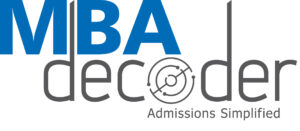
An MBA resume is a snapshot of your professional and academic profile, what you do outside of work, for the community, and your personal development. It’s your brand statement, which is usually the first document read in the application and sets the tone for what to expect from the rest of the application.
Therefore, you must submit absolutely the BEST resume, which the adcom will remember from among a pool of countless other applicants who look like each other’s carbon copies because their resumes don’t help differentiate them.
The MBA Decoder team recently conducted a webinar on creating a compelling resume for b-school admission. Here’s what we talked about:
The most common mistakes applicants make:
- They write too much and want to describe every single project they worked on, often giving their entire job description. As a result, their most significant stories tend to get lost in the clutter.
- They start their bullets with boring action verbs that make them come across as doers or order-takers, not achievers or initiators. They use words such as analyzed, assisted, collaborated, communicated, and so on without realizing that it’s difficult to quantify impact and demonstrate achievement through such words.
- They show only personal achievements by using phrases such as “Single handedly managed”, “Hand-picked to execute…”, “Won an award” and “Adjudged best analyst…”. While it’s okay to show personal mastery, having all bullet points that only talk about personal achievements reflects an inability to see the larger picture and positively impact business outcomes.
- They overuse buzzwords without quantifying the outcome. Excessive use of words like strategized, actualized, and synergized dilutes their impact. Also, acronyms or industry jargon should not be used, as they will not be understood by everyone.
- Sometimes, applicants exaggerate numbers which sound too good to be true. Remember that if any part of the resume sounds wrong to the reader, whatever follows after that will only create further doubt.
- They fail to mention extra-curricular and community activities that help show a well-rounded profile and the willingness to take up activities outside work responsibilities. This can make the adcoms wonder whether the applicant will be an active member of their b-school community.
During the webinar, we show you how to avoid these common mistakes by providing relevant examples.
We also ask you to abandon the PAR (Problem Action Result) approach to framing your pointers. Instead, we recommend our FAR MORE EFFECTIVE approach—ASPA—Achievement by Solving Problem (through) Action. This approach requires you to show the achievement first by solving a problem by taking action. This enables you to bring your impact upfront. We have been practising this over the years to build exceptional resumes for our applicants.
Next, we discuss four case studies of ineffective resumes and how we transformed them, helping applicants get admitted to business schools such as Wharton, Ross, Booth, and Kellogg.
Case Study 1 shows how an excessive number of pointers, often only stating responsibilities, clutters your resume and hides your real achievements. We coach you to select your most significant achievements and use language that connects them with your career goals, thereby tying your story together as a cohesive piece.
Case study 2 shows how you can present yourself as a boring doer by using words such as “Worked with”, “Collaborated with”, and “under the guidance of manager”. These words make you a follower and not someone who takes initiative. We explain how to use appropriate impact verbs followed by quantified achievement to create impressive pointers.
Case Study 3 shows how buzzwords dilute the brand “YOU.” Applicants overuse words such as systemized, strategized, analyzed, and so on. Or they use industry jargon that is not understood by most people. We teach you to replace meaningless buzzwords with meaningful, result-oriented words that make your resume punchy and compact and establish you as the grand achiever.
Case Study 4 shows how applicants make glitches in the additional information section of the resume by not showing their leadership and impact or skills and experiences that will be relevant at a business school. We coach you to highlight the right examples that show your leadership and ability to contribute to the business school environment.
Finally, we give tips on five things to remember when drafting your resume for MBA applications. These include:
- Making every word count
- Quantifying impact
- Showing skills in line with your goals essay
- Demonstrating leadership
- Using relevant action verb
.
